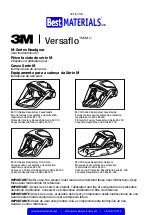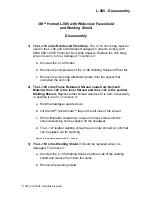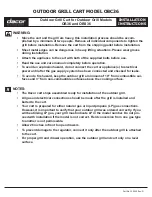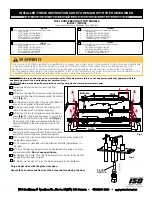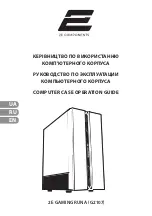
32
0
6/16 - Subject to change. © Belimo Air
controls
(USA
), Inc
.
ZIP Economizer
Method of Operation
Sequence of Operation
States
Virgin State
The ZIP Economizer comes shipped from the factory in this state. “Setup
Incomplete” will be displayed. No control will occur until setup is completed.
Automatic State
– all of the following strategies and operational modes are
available in this state.
A minimum of two pieces of information (in level 2 Settings menu) must be
entered before the ZIP Economizer will go into Automatic State:
• The appropriate ZIP code must be entered.
• The minimum damper position setpoint (Vent Min Pos) percentage must be
entered.
When in Automatic State, the G input terminal is used to monitor a remote
occupancy contact, time clock and/or indoor fan signal. When the G terminal is
energized, the ZIP Economizer will operate in Occupied (damper will move to
the proper ventilation position). Otherwise, the ZIP Economizer will operate in
Unoccupied.
Strategies
Compressor Protection and Energy Savings
DXLL
(Supply Air Low Temperature Protection in Mechanical Cooling)
This strategy is activated automatically when in Mechanical Cooling Mode
depending on supply air temperature. Timers, temperature dead bands and
SAT Y2 Limit setting all interact with this strategy.
SAT < 45°F
All compressor stages disabled.
45 °F
SAT < 47°F
Compressor stages may or may not
be enabled based on whether or not
SAT is rising or falling.
SAT
47°F and SAT Y2 Limit=Off
Both compressor stages enabled.
47°F
SAT < 56.5°F and SAT Y2
Limit=On
1st stage compressor enabled.
2nd stage compressor disabled.
SAT
56.5°F
Both compressor stages enabled.
SAT Y2 Limit
This strategy inhibits the 2nd stage compressor from coming on prematurely
based on SAT temperature and time.
• IF Y2 is energized
AND Compressor 1 has been running for less than 4 minutes
AND Supply Air Temp is less than or equal to its required se 1.5°
(56.5°F)
THEN Compressor 2 will not be allowed to come on
LCLO (Low Ambient Compressor Lockout)
This strategy inhibits compressor operation at low outdoor air temperatures.
• IF OAT falls below the low limit (50°F)
AND not in Heat Pump Mode
THEN Compressor 1 and Compressor 2 will be disabled.
• IF OAT rises 2°F above the low limit (52°F)
OR in Heat Pump Mode
THEN Compressor 1 and Compressor 2 will be enabled.
Minimum On and Minimum Off Time
This strategy prevents the compressors from “short-cycling”.
• IF any Compressor is energized
THEN run it at least 180 seconds EXCEPT when entering Brownout Mode
when compressors will be shut off immediately.
• IF any Compressor is de-energized
THEN keep it off for at least 180 seconds
Not Simultaneous ON/Not Simultaneous OFF
On RTUs with 2 compressors this strategy is used to prevent both compressors
from coming on at the same instant to keep electrical demand down.
• Compressors 1, 2 are kept from switching on together by a 10 second time
delay.
• If SAT Y2 Limit is set to “On” compressor 2 is delayed by 240 seconds to
evaluate if the single compressor already operating can bring SAT less than
or equal to se1.5 °F (56.5°F).
• Compressors 1, 2 are kept from switching off together by a 5 second time
delay EXCEPT when entering Brownout when compressors will be shut off
immediately.
Brownout Protection
Input power (24 VAC) is monitored.
• IF input voltage drops to 75%
AND it stays below there for 30 seconds
THEN Brownout will be enabled.
• IF input voltage rises to 85%
AND it stays there for 300 seconds
THEN Brownout will be disabled.
Under Brownout conditions the current operating mode will be maintained
EXCEPT Mechanical Cooling and Integrated Cooling (where compressors are
utilized).
Instead of Mechanical Cooling it will go to Ventilation, DCV or Unoccupied.
Instead of Integrated Cooling it will go to Free Cooling.
This strategy prevents compressor operation during brownout conditions.
Compressors will be turned off immediately (bypassing minimum on/off
timers).
Random On Delay after Power Up
After a power blackout or any power restore, compressors will go through
a random time delay before allowing them to operate. This random timer is
between 30-180 seconds. This helps the electrical network to come back up
without excessive demand from multiple RTUs and compressors coming back
on after the blackout.
Freeze Protection
See Freeze Protection Mode of Operation below.































